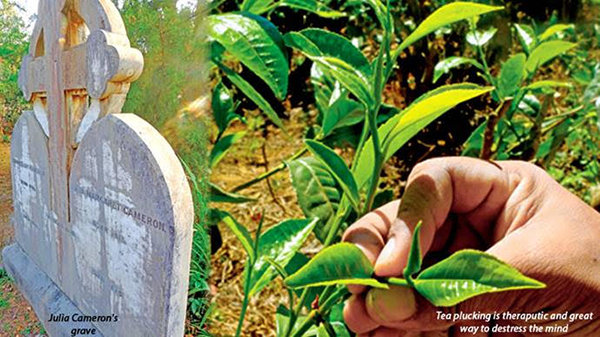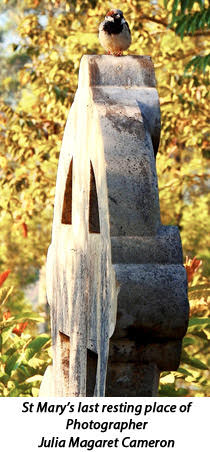The Golden Valley’s Tea of Life
Friday, September 4, 2020 – 01:00
Print Edition


Sir Arthur Conan Doyle the writer of Sherlock Holmes said: “The tea fields of Ceylon are as great a monument to courage as the plains of Waterloo.”
Tourism trends show that the future is making the most of the great outdoors, from Street art on village walls to ancient trails through tea estates, where social distancing is easier than the crowded cities and in a way more in line with the first pioneers who first visited the country. Norwood is a stunning place to unplug and reboot ones mind, being a stunning area with only a small village in the Central Province, known as ‘The Golden Valley of Tea’; a place you can try your hand at picking tea, only to realise it takes both talent, experience and dextrous speed, to keep up with the Norwood plucking ladies who have been doing this for generations. If you want to disconnect yourself from the outside world then this is the place to do it, walking along ancient tea trails.
To learn about the rich culture of the people living in the area, it is worth studying the most significant 19th century female British photographer, Julia Margaret Cameron, who was totally bewitched by Sri Lankan plantation life and the incredible medicinal knowledge of the local people. Leaving Norwood Ceylon Tea Trails Bungalow behind you, with its fine views of the eastern end of the Bogawantalawa valley, head along the trail to the next valley to find St Mary’s church, where Julia Margaret Cameron is actually buried, not Tiensen as many people suggest named after the Chinese village that the original tea seedlings came from. It is here that this famous photographer of the people of the coffee and later tea country was buried in 1879, at the age of 63, having spent six years producing wholly original portraits of the islanders way of life. Cameron originally went to Sri Lanka, then Ceylon, to help manage the family coffee plantation, which was badly damaged by the blight, but was soon mesmerised by the strength and extraordinarily powerful spirit and knowledge of the people of the hills.
Her black and white photographs, already well known in London society, showed a new level of respect for these hardy characters of the hills, unmatched even to this day by other portrait photographers. Always supported by her coffee farming husband, Cameron wrote: “My husband, from first to last, has watched every picture with delight, and it is my daily habit to run to him with every glass photographic plate upon which a fresh glory is newly stamped, and to listen to his enthusiastic applause.”
Her obsession, to capture the beautiful people of the hills as she walked through the plantations daily learning about everything from family traditions to festival ways of life. Cameron’s dramatically lit pictures, with soft focus and angles that looked up at those she captured uniquely caught the inner strength of these inspirational people whose descendants still live in these remote pockets; copies can be seen in Tiensin Bungalow. With this in mind, Bogawantalawa, The Long Valley is a serene spot, unchanged for centuries, full of eccentric characters who are considered the pioneering spirits of Ceylon Tea. The Long Valley is a place that is so picturesque and old world one can see why stories hark back to a time when the planters would travel on horse back or walk through the tea fields and forests, collecting the freshest tips so they continually refine tea was made. Today many of the roads that lead to these more remote areas are covered in Street art communicating a modern message about the lives of the people in this fascinating area.
I learn as I walk each day how over hundreds of years, people from different religions have intermarried and this has brought deep harmony to the area, as through this, they have come to understand each others’ differences, which they respect through working alongside each other, on one of the country’s biggest foreign currency earners – tea. ‘Cultural mixation’, does not allow space for conflict, as the people of the hills understand and learn that there are many different approaches to solving a problem and living a good life. This mixation leads to excellent community teamwork, and self development, which should really be the model for the world to learn from. A common goal, now, is to work for higher economic and sustainable development, of the tea industry, which they hope will spread to all other areas of working practices. The most important resources in any country, after all, are the humans and their wellbeing. As I head past a kovil and a chapel side by side, with the mosque a short distance away, one realises with only a back pack with food and clothing that “Everyone has a job and purpose here. There are no time wasters like in the West, owing to family and work responsibilities, and social respect, reinforced by the highly respected elders, that connects one generation to the next and is embedded in everything they do.” Knowledge and ethics are always good for communication and, in particular, the social development and wellbeing of its community in the long term, as sometimes, you need to be reminded that what you do is special and helps the country to thrive and share its natural gifts from the gods, with the outside world. Tea has always given people a chance to sit down and take stock of any situation and make a plan. Now it is a excellent solution for a social distancing break in the tea country, that will not only get you fit, but also allow you to enjoy centuries of natural wisdom in places where pioneers have always led the way. So mask up and head for the hills for a truly holistic holiday.








No Comments